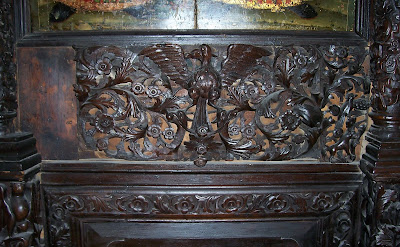Proposition: Once a theological formula is published, its interpretation cannot be limited to its original purpose and context.
This idea was a by-product of my thesis on the Formula of Reunion (433). It might find its way into my thesis in some form.
Exhibit 1. The Nicene Creed was formulated to rule out Arianism. This is made explicit in the final section, which anathematizes those who employ Arian formulae and terminology:
Those who say, ‘There was when he was not’, and ‘Before being begotten he was not’, and that he came into being from things that are not, or assert that the Son of God is from another hypostasis or substance or is changeable or alterable, these the catholic and apostolic church anathematizes.
But once that heresy had been extinguished (at least in the eastern Mediterranean – it hung on among some German tribes for another three centuries), the anti-Arian creed was not set aside. Rather, it became a touchstone of Orthodoxy. Its most prominent exponent, Athanasius, was elevated to sainthood as his generation’s paragon of orthodoxy, while Arius became forever the archetypal heretic. Adherence to “the faith of Nicaea” came to distinguish orthodox Christians not only from Arius, but also from later heretics, like Eunomius, Apollinarius, and Nestorius.
Since the Arian controversy had begun as an intra-Alexandrian affair before it spread abroad, certain assumptions shared by Arius and his local Alexandrian opponents were embedded in the arguments of both sides, as well as in the Nicene resolution. Athanasius’s successors Cyril and (especially) Dioscorus tried to interpret Nicaea not just as a negative statement ruling out Arianism, but as a positive statement enshrining the local peculiarities of Alexandrian Christology for the entire Church. (This might explain why Cyril was a stickler for the exact creedal formula approved by Nicaea, in opposition to the many other “Nicene” creeds in use in the early fifth century, which assimilated key Nicene phrases to existing local baptismal creeds.)
Exhibit 2. In his Letter to Acacius of Beroea (Ep. 33), Cyril of Alexandria defended his Twelve Anathemas by insisting that they were to be read only in opposition to Nestorius:
But the force of the statements was written only against the teachings of Nestorius. For they throw out what he said and wrote in error. Those who anathematize and deny his evil teaching will cease to object to the documents which have been written by us. For they see that the meaning of the statements only goes against his blasphemies. (John I. McEnerney, trans., St. Cyril of Alexandria: Letters 1-50, The Fathers of the Church 76 (Washington, DC: Catholic University of America Press, 1985), 133.)
But neither his theological allies nor his opponents read Cyril’s Anathemas in such a circumscribed, negative way. They read the Anathemas as a more general Christological statement with positive implications, seeing them either as an essential supplement to the Creed of 325 or as a revival of the heresy of Apollinarius (on whose writings Cyril had unwittingly drawn in formulating them). After the Reunion of 433, though Cyril never explicitly renounced the Anathemas, neither did he continue to emphasize them, and they faded into the background for the last decade of his life. But after his death, those who proclaimed themselves loyal to the memory of Cyril (a very selective memory that ignored the historical Cyril’s commitment to the Reunion of 433) denounced the terms of the Reunion and revived the Anathemas as a litmus test of orthodoxy. Eventually, long after the Nestorian heresy had been driven out of the Church, the Second Council of Constantinople (553) elevated Cyril’s Third Letter to Nestorius with the Twelve Anathemas to dogmatic status in an unsuccessful attempt to placate the enemies of Chalcedon.
Exhibit 3. In an appendix to his Tome to the Armenians, Proclus of Constantinople condemned selected passages from the writings of Theodore of Mopsuestia. When he demanded that the Syrian bishops formally endorse both the Tome and the appended condemnations, they objected that the passages from Theodore had been removed from their proper literary, historical, and theological context. In his polemics against the Arians, the Syrian bishops said, Theodore had been driven to a
certain great distinction (i.e., between the natures in Christ), not coming to it from a depraved understanding, but deciding to use that mode of expression more efficaciously against the heretics, and he was not ignoring nor denying the total unity, far from it, for all his books are full of this mode of expression, but he was dividing the properties of the natures more fully as the fight which he had against the heretics dictates that he should do. (Nicholas Constas, Proclus of Constantinople and the Cult of the Virgin in Late Antiquity: Homilies 1-5, Texts and Translations, Supplements to Vigiliae Christianae 66 (Leiden: Brill, 2003), 117.)
But some Antiochene bishops, like Ibas of Edessa, did not restrict their reading of Theodore’s polemical extracts to an anti-Arian context any more than his enemies did.
This idea was a by-product of my thesis on the Formula of Reunion (433). It might find its way into my thesis in some form.



















































































